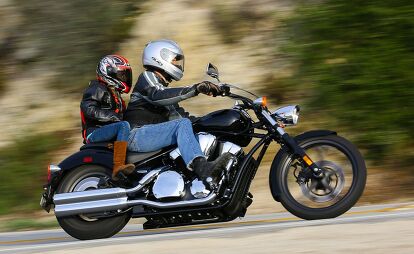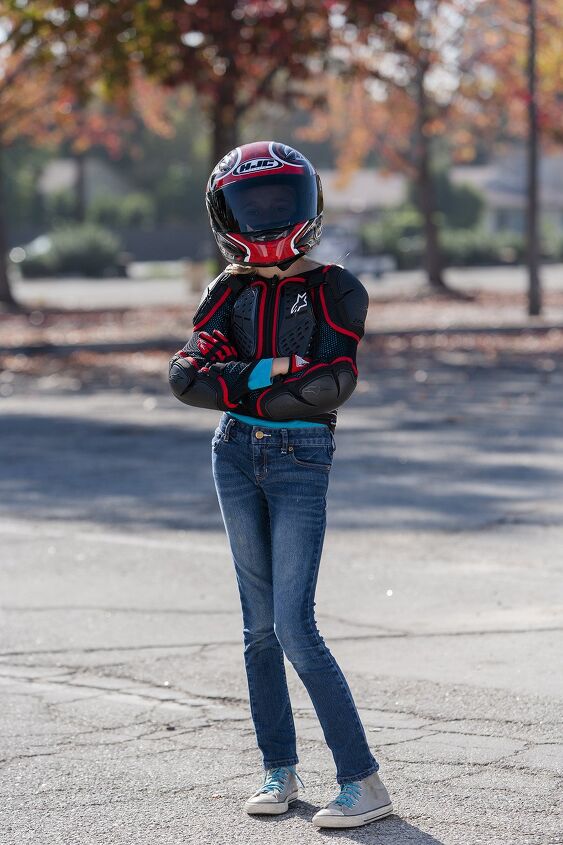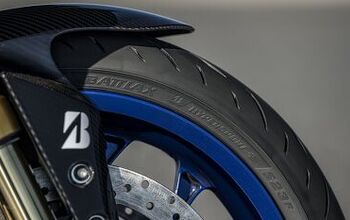Evans Off Camber – Precious Cargo: Riding With Kids

From the moment my first child was born, I began planning for the day that she would ask me to take her for a motorcycle ride. As a person who’s devoted over half of my life and the bulk of my career to motorcycling, I couldn’t imagine not sharing this activity with my children. However, my wife and I often have differing opinions (Since dealing with conflict promotes personal growth, perhaps this is why I married her.), so I figured it would be a good idea to discuss my hopes with her long before our girl popped the question.
Not surprisingly, my wife’s definition of acceptable risk is more restrictive than mine. Through our discussions over the next few years, we developed a plan: Our daughter was welcome to sit on the bike in our presence any time, but she must ask first. However, she had to wait until she was tall enough to touch the pegs in order for us to even consider taking her for a ride. As she grew taller with the big day growing closer, we also added the requirement that she be able to ride her bicycle without training wheels. The reach to the pegs shouldn’t require explanation. The bicycle requirement came about as a result of our conversations. We decided that she would benefit from having a basic understanding about the dynamics of riding on two wheels. Additionally, through the natural results of the learning to ride a bicycle, she would have already earned the skinned knees associated with upsetting a bicycle’s balance.
Bring Your A Game
Taking your child for his/her first motorcycle ride shouldn’t be something that just happens, but I’m afraid for all too many parents it is. My belief, as a former motorcycle safety instructor, is that preparing to take your child for a ride begins with a close look at yourself as a rider. As adults, we have the capacity to make a reasonable judgement as to the risks we take with our lives and physical well-being. Children are not capable of such abstract thought – much less the impulse control required for many activities. So, taking a hard look in the mirror and assessing your riding skills, without bravado, is vital.
Consider these questions as a starting point: Can you pull away from a stop smoothly? Are your shifts smooth or do you bang helmets with your passengers? Can you brake and downshift for a corner without upsetting the bike’s chassis? Do you use both brakes to come to a smooth stop onto your left foot, every time? When was the last time you practiced a full-boogie panic stop? How did it go? What is your greatest weakness as a rider?
If any of these questions makes you think that you could use a little brushing up of your basic riding skills, take heart: By honestly assessing your capabilities, you’ve already started to improve them. Perhaps you should set some time aside to knock the rust off your techniques. Or sign up for a MSF course.
The fact that we should be performing at our very best when carrying our most precious cargo on a motorcycle can’t be overstated.
All the Gear All the Time
The main reason that you should plan ahead before taking your child for a ride is that getting the right gear takes some leg work. First and foremost, you need a helmet that properly fits your child. While an oversized jacket may look funny on a kid, it’ll still offer protection in a tumble. However, an ill-fitting helmet can injure, rather than protect, your child. So, look for child-specific, DOT legal helmets.
At the risk of offending riders who prefer open-face or half-helmets, I believe children should only wear a full-face helmet. As adults, we understand the implications of being hit by bugs or rocks and can make a reasoned decisions about the amount of abrasion and impact protection we are willing to trade away for image. Children have neither the maturity nor the experience to make this decision. Therefore, we should make the most conservative choice for them. (While you’re pondering which full-face helmet to buy your kid, ask yourself why you’re willing to exchange a percentage of your own safety for fashion.)
The following manufacturers have kid-sized helmets available at the time of publication: BiLT, GMax, HJC, Vega, and Z1R.
When it comes to protecting the rest of your child’s body, you’ll have to do a little investigation. Cheap motorcycle-fashion gear is available from a variety of outlets, but if you’re interested in real riding gear, be prepared to spend a little time finding the right stuff. (Update: I want to thank the reader, Speedwayrn*yahoo.com, who pointed out that I neglected to mention KinderRider as a place to find child-sized riding gear. Thanks!) I ended up separating the impact protection from the abrasion resistance. The Alpinestars Youth Bionic 2 Protection Jacket features an adjustable mesh liner with CE arm, chest and back protectors attached. With the armor separate from the jacket, I have the freedom to vary the outer jacket according to the season. During warm weather around town, my daughter wears just the Bionic. For longer rides, she prefers my wife’s Vanson leather jacket.
As far as gloves and boots are concerned, it’s hit and miss. Kids gloves go in and out of production. Just look around. I’ve also had occasional good luck just browsing my local motorcycle dealerships for no name brand leather gloves. Although there are tons of motocross boots available, streeting options are almost nonexistent. I’ve opted for cowboy boots or high topped hiking boots for my daughter. Also, I’d love to have more protective options than the jeans she wears when we ride.
Even the most attentive kid will let her focus wander, and the back of a motorcycle is about the worst place for that to happen. Then there’s the possibility of her not being strong enough to hold on if the bike goes over a large bump. The Children’s Riding Belt, developed by Canadian rider B.J. (Ivan) Arsenault, has been around in various forms for a number of years. The belt secures your small passenger to the rider via a harness while also providing motorcycle grips for her to hold on to during the ride. The Child’s Riding Belt can be difficult to find with the only contact information I can find located on a Facebook page that hasn’t been updated in a few years. The BackRider belt appears to be a variation on the same theme. Finally, Moto-Grip and Moto-Grip Jr. look to be viable options. Additionally, the Grip-n-Ride belt offers two pairs of handles without the harness. (Perhaps a group test of these products is in order.) Since all but one of these affix the child to the rider’s body, I would be remiss if I didn’t point out the risk of having a child lashed to you in an accident. Personally, I’ve decided that the benefits outweigh the hazards.
School is in Session
Before I took my daughter for her first ride, we had a few serious talks where I laid down the three rules for being a passenger. I didn’t allow her to take a ride until she could repeat all of the rules back to me. They were:
- The passenger always holds on to the rider.
- Feet must stay on the pegs at all times.
- Do not lean from side-to-side. It can cause an accident. (This is where being able to ride a bicycle helps her to understand.)
Ride your child around a large parking lot before venturing on to the street. Begin with the basics, like how to properly mount and dismount. Similar to a MSF class, progress a step at a time with distinct breaks between each exercise. Have your child sit on the bike and, while both of your feet are firmly planted, have her lean one way and then the other. This provides an example of how she can effect the bike. Riding in a straight line and coming to a safe stop acclimates your child to the sensation of riding and gives you the opportunity to explain that you are extremely vulnerable to her movement when speeds are low.
Before you advance to riding in circles, tell your child to look to the inside of the turn. Don’t talk to them about leaning; the inside look will take care of that. Kids love weaving around cones because they get to feel the bike move from side-to-side underneath them.
Once both you and your child are fully comfortable with the above skills, begin performing some faster stops, building intensity with each iteration until you both are familiar with the dynamics of a quick stop. Before moving on to the street, discuss any questions your child may have about the ride and the exercises you performed in the parking lot. Choose quiet streets and gradually build up to higher speeds.
Giving passengers a way of telling me when something is scaring them helps to keep them calm. I have them tap me three times on my right thigh as their signal and promise them that, when they use the signal, I will stop as soon as its safe to discuss their concerns. If your child, at any time, expresses trepidation about the speed from, say, riding on the highway, don’t try to talk her out of it. Rather, acknowledge the fear and choose a slower route until she is more comfortable.
If you’re lucky, your child will love riding and want to share your passion. So, consider your child’s comfort and safety during these first rides, and you’ll be on your way to having a great passenger and maybe a future riding buddy.

Like most of the best happenings in his life, Evans stumbled into his motojournalism career. While on his way to a planned life in academia, he applied for a job at a motorcycle magazine, thinking he’d get the opportunity to write some freelance articles. Instead, he was offered a full-time job in which he discovered he could actually get paid to ride other people’s motorcycles – and he’s never looked back. Over the 25 years he’s been in the motorcycle industry, Evans has written two books, 101 Sportbike Performance Projects and How to Modify Your Metric Cruiser, and has ridden just about every production motorcycle manufactured. Evans has a deep love of motorcycles and believes they are a force for good in the world.
More by Evans Brasfield





































Comments
Join the conversation
Good information. For those who have access to one, taking your son or daughter on the back seat of a tandem bicycle Is a good way to get them acclimated to the motorcycle.
Also, I have vivid memories of being taken for a ride by an older relative when I was young, and being scared to death of the speed. When taking friends, nieces, and nephews, be especially conservative with the speed! Even legal speeds can be scary to a newbie.
Wanted to say Thank you for a great article . You provide much need info . I am looking to become a MSF instructor at some point in my life . Right now my Children both want to ride with me and though I have grown up on two wheels (thanks my grandparent's) as an Adult and Knowing the very real risk of riding , Knowing this and allowing any children on the back of my bike is something that has kept me up at night .
So far they have been on rides around the battlefield's as the speed limit is 15 mph and there feel safe with that and Full gear on . No Gear no ride . first rule for me and them and I've tested them on this when I tried to leave with just a jumper on or incorrect foot wear .
Again thank you for the article.